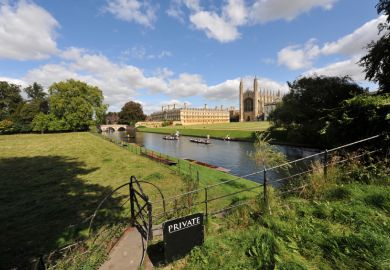Students from English state schools have fallen further behind their private school counterparts on access to the UK’s most selective universities, data show.
Statistics released by the UK’s Department for Education reveal that 63 per cent of students who took A levels and equivalent qualifications in 2012-13 had entered higher education by 2014-15, up 1 percentage point on the previous cohort.
For independent school pupils, the participation rate remained at 85 per cent, meaning that the gap between the two sectors shrunk by 1 percentage point, to 22 percentage points.
However, this remains significantly larger than the gap reported in 2008-09, of 12 per cent.
And, when admissions to just the UK’s most selective universities are considered, the trend is moving in the opposite direction, with the participation gap between state and independent schools growing from 42 per cent to 43 per cent year-on-year.
This was despite an improvement in the performance of state schools, which saw their entry rate to highly selective universities climb from 22 per cent to 23 per cent year-on-year. For independent schools, the entry rate is 65 per cent.
The gap has grown by 6 percentage points since 2008-09, when it stood at 37 percentage points.
The DfE data also show that the gap in higher education participation between students eligible for free school meals and those who are not has grown slightly, to 18 percentage points.
Twenty-four per cent of pupils eligible for free school meals at the age of 15 had entered higher education by the age of 19 in 2014-15, up 2 percentage points year-on-year. However, the participation rate among those not eligible for free school meals also grew by 2 percentage points, to 41 per cent, meaning that the gap grew by 1 percentage point.
There is significant regional variation in the size of the gap, with the smallest differences found in Inner London (8 percentage points), Outer London (14 percentage points) and the West Midlands (17 percentage points).
All other English regions report a gap in excess of 20 percentage points, with the difference being largest in the South East and the North East (both 24 percentage points).
Alistair Jarvis, the acting chief executive of Universities UK, said that all higher education institutions were “committed to widening participation and to ensuring that everyone is given the right support to succeed”.
“Universities have made considerable progress in this area in recent years, but there is more work to be done,” he said.
Find out more about THE DataPoints
THE DataPoints is designed with the forward-looking and growth-minded institution in view
Register to continue
Why register?
- Registration is free and only takes a moment
- Once registered, you can read 3 articles a month
- Sign up for our newsletter
Subscribe
Or subscribe for unlimited access to:
- Unlimited access to news, views, insights & reviews
- Digital editions
- Digital access to THE’s university and college rankings analysis
Already registered or a current subscriber?




